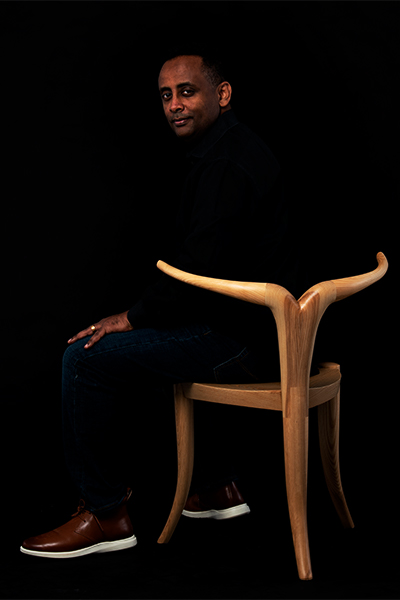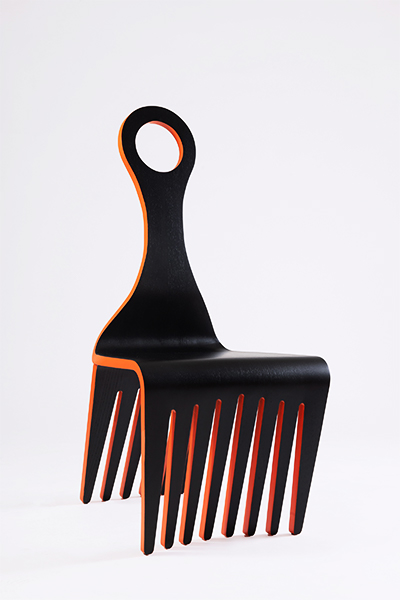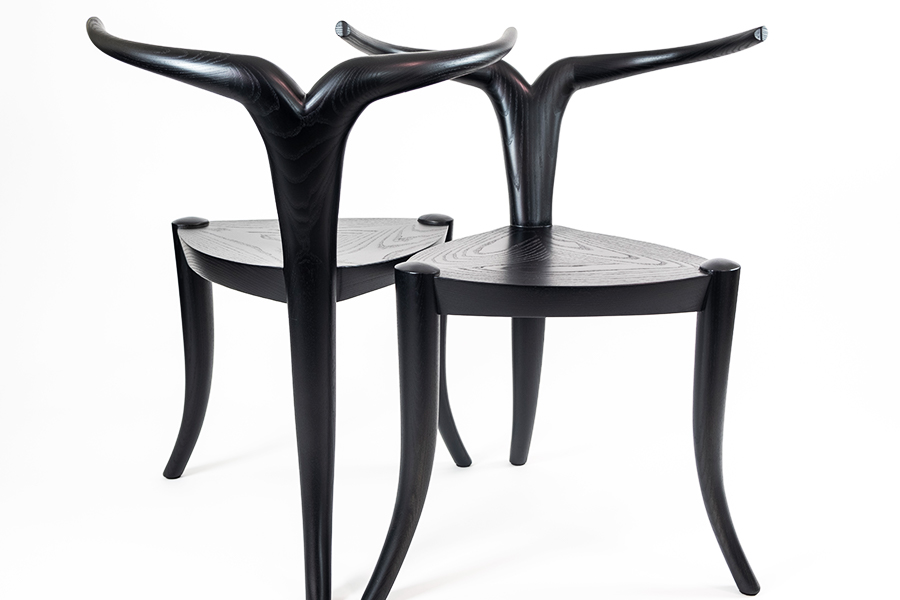African legend: Jomo Tariku
The Ethiopian-American designer on the lack of Black design creatives and seeing his work in the Black Panther sequel
There’s something strange in Jomo Tariku’s living room. Crammed in front of his fireplace is a collection of curious wooden objects: squat three-legged stools, hollow cylinders and chiselled blocks that look like giant chess pieces.
These are the Kenyan-born, Ethiopian-raised and now USA-based furniture designer’s creations in one of their rawest forms. These rough prototypes go through many stages in their slow metamorphosis from scribbled thumbnail sketches to shiny, lacquered objects that look like mysterious ancient treasures and sleek modern art pieces all at once.

Jomo Tariku on his Nyala Chair / Image: ©Gediyon Kifle

Meedo Chair by Jomo Tariku
Without even realising it, you may have already seen Tariku’s creations through their cameo appearance in the blockbuster movie Black Panther: Wakanda Forever. His designs fit effortlessly into the film’s Afrofuturistic aesthetic – a mixture of traditional African colours and patterns with avant-garde flourishes that won production designer Hannah Beachler an Oscar for the franchise’s original 2018 film. “Most of us designers would hope our work gets collected in a museum. But being in movies was never even on my radar,” says Tariku. “And of all movies… Black Panther! Its cultural impact is huge.”
In 2021, Beachler curated Before Yesterday We Could Fly: An Afrofuturist Period Room at New York’s Metropolitan Museum of Art, where you’ll find one of Tariku’s most arresting pieces of furniture: a chair shaped like a giant Afro comb. It was through this connection that he got the call asking for five of his designs to feature in Wakanda’s Afro-punk universe. Keep your eyes peeled in the film’s final living room scene and you’ll spot Tariku’s Nyala Chair, gracefully shaped like the horns of the Eastern/Mountain bongo antelope (found in Ethiopia’s Bale Mountains) and his bulbous Mukecha Stool inspired by traditional African mortars for grinding coffee beans.
But getting them on screen was no easy feat. The producers needed a slew of replicas, which meant a “mad dash” to deliver them on time. Tariku squeezed the milling, cutting and glueing into his evenings and weekends, juggling the work alongside his day job as a graphic designer and data scientist at the World Bank, even sketching ideas for his studio, Jomo Furniture, on his 5am commute.
Tariku’s no stranger to this kind of sacrifice and turbulence, as both have been features of the 54-year-old’s entire career, which has taken many twists and turns before his big silver screen moment.

Jomo Tariku’s Mukecha Stool

Tariku’s design story starts with his father. An Ethiopian military attaché, he proudly displayed all the unique gifts he received when travelling for work in their home in Addis Ababa. “It was pretty eclectic,” says Tariku who recalls a childhood house packed with Persian rugs, cigar humidors from Nairobi, Eastern European glassware and Indonesian furniture. “They were objects of curiosity for me. I would sit for hours sketching them.” His mother’s job at Ethiopian Airlines meant the family were able to travel around the world, “and that curiosity of mine got expanded,” he says.
It was an inquisitiveness that took him to the USA to study computer science at the University of Kansas before a professor introduced him to industrial design. “I enjoyed it from the moment I started,” he says. “I did my thesis on African furniture because I noticed a real lack of modern African styles in the magazines and books I was reading. It was a problem I knew had to be addressed and I’ve never looked back.”
“It was rare to see anything informed by Black culture... if I wasn’t one of the people to fix it, who else?”
Between 2000 and 2008 Tariku founded a furniture studio with his childhood best friend, but was forced to close it when the global financial crash hit. Despite this, he continued displaying pieces at trade shows around the world but became increasingly frustrated. “I’d go to these shows and there’d be virtually no Black designers. It was rare to see anything informed by Black culture. It was intensely discouraging, but if I wasn’t one of the people to fix it, who else?” Using his background in data science, Tariku even undertook his own research in 2020, which found less than one percent of all furnishings produced by international brands are by Black designers.
Championing his African heritage wasn’t just an artistic statement for Tariku, but a call to shake the design industry to its core.

Ashanti Stool by Jomo Tariku

To expand people’s perceptions of African design, Tariku absorbs everything from the continent’s ubiquitous craft objects and wildlife to its landscapes and unique histories, and uses them as launchpads to inspire his creations. His Ashanti Stool is a modern take on the symbolic thrones of the Ghanaian Ashanti people. His Boraatii Stool/end table is influenced by Ethiopian headrests used to protect the flamboyant hair weaves of people of the Oromia region while they sleep.
Each design can take weeks, if not months, of research. Even choosing the name of each piece is a painstaking process. It took months for Tariku to christen his latest design, which replicates the African birthing chairs that can be taken apart and reassembled, the Qwanta Totem Chair. “I always try to name my work after what inspired it,” he says. “It can be hard. Documents may be written in Amharic or not there at all, but I really want people who find my work to do their own research and continue the journey themselves.”
In addition to his blockbuster cameo, the last two years have seen Tariku’s work featured in Denver Art Museum, Baltimore Art Museum, the acclaimed Wexler Gallery and at Design Miami – a special show for Tariku whose mother was able to attend after not being able to visit the US for 15 years. “She has eyesight problems so wasn’t able to clearly see my work, but she could feel it.”

Nyala Chairs by Jomo Tariku

Tariku attributes the recent impact of his work to the Black Artists + Designers Guild. Founded by New York-based textile designer Malene Barnett in 2018, it aims to address the scant number of Black creatives in the design industry. She invited Tariku to become a co-founder and “the ripple effect has been staggering.”
“My dad passed away two years ago and it’s frustrating he never got to see my success, because it shouldn’t have taken me 30 years to make it to a major show,” he says. “It’s never about talent, it’s about access. Coming from developing countries, most of us will never reach the people who make decisions about our work. That’s what we want the guild to change. It’s about passing the torch. Showing young African kids this is a career option.”
As for the future, 2023 holds further museum appearances, speaking engagements and the prospect of a European show, but among all this glittering success, Tariku’s passion for his childhood home stays strong. “Growing up, we’d drive around, stopping to talk to the craftspeople in small towns selling wooden crafts and copper plates by the street. These are the people that influence me, these are the people I want to credit and uplift. These are the people I want the world to see.”
Read more about Jomo Tariku’s work at jomofurniture.com.